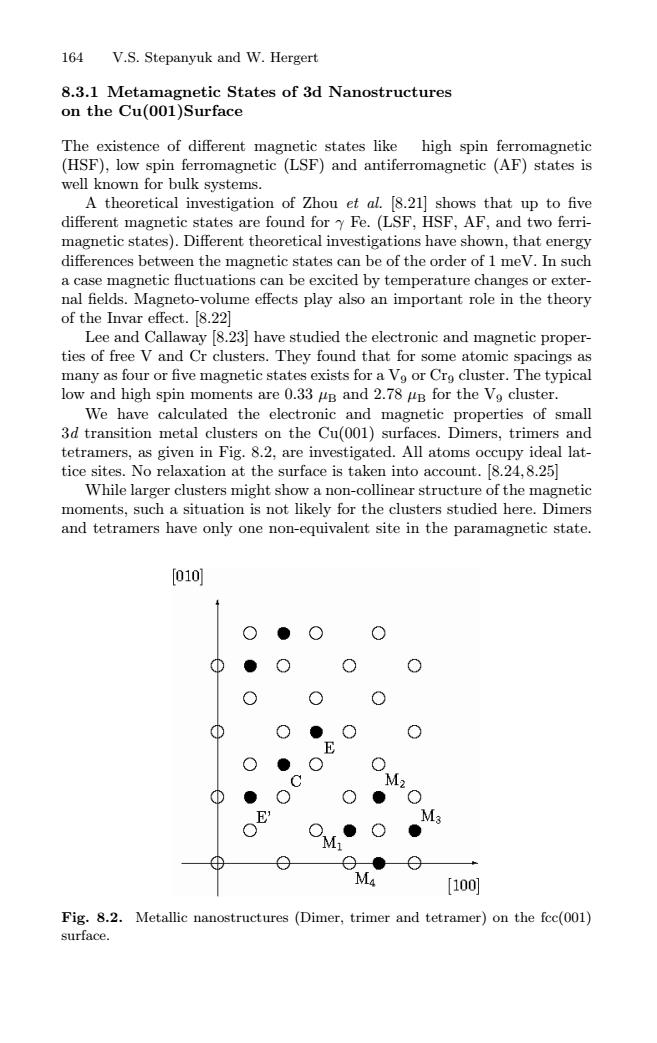正在加载图片...

164 V.S.Stepanyuk and W.Hergert 8.3.1 Metamagnetic States of 3d Nanostructures on the Cu(001)Surface The existence of different magnetic states like high spin ferromagnetic (HSF),low spin ferromagnetic (LSF)and antiferromagnetic (AF)states is well known for bulk systems. A theoretical investigation of Zhou et al.8.21]shows that up to five different magnetic states are found for y Fe.(LSF,HSF,AF,and two ferri- magnetic states).Different theoretical investigations have shown,that energy differences between the magnetic states can be of the order of 1 meV.In such a case magnetic fluctuations can be excited by temperature changes or exter- nal fields.Magneto-volume effects play also an important role in the theory of the Invar effect.[8.22] Lee and Callaway [8.23]have studied the electronic and magnetic proper- ties of free V and Cr clusters.They found that for some atomic spacings as many as four or five magnetic states exists for a Vo or Cro cluster.The typical low and high spin moments are 0.33 uB and 2.78 uB for the Vo cluster. We have calculated the electronic and magnetic properties of small 3d transition metal clusters on the Cu(001)surfaces.Dimers,trimers and tetramers,as given in Fig.8.2,are investigated.All atoms occupy ideal lat- tice sites.No relaxation at the surface is taken into account.[8.24,8.25] While larger clusters might show a non-collinear structure of the magnetic moments,such a situation is not likely for the clusters studied here.Dimers and tetramers have only one non-equivalent site in the paramagnetic state. [010 ① E E M3 M Q● M4 [100] Fig.8.2.Metallic nanostructures (Dimer,trimer and tetramer)on the fcc(001) surface.164 V.S. Stepanyuk and W. Hergert 8.3.1 Metamagnetic States of 3d Nanostructures on the Cu(001)Surface The existence of different magnetic states like high spin ferromagnetic (HSF), low spin ferromagnetic (LSF) and antiferromagnetic (AF) states is well known for bulk systems. A theoretical investigation of Zhou et al. [8.21] shows that up to five different magnetic states are found for γ Fe. (LSF, HSF, AF, and two ferrimagnetic states). Different theoretical investigations have shown, that energy differences between the magnetic states can be of the order of 1 meV. In such a case magnetic fluctuations can be excited by temperature changes or external fields. Magneto-volume effects play also an important role in the theory of the Invar effect. [8.22] Lee and Callaway [8.23] have studied the electronic and magnetic properties of free V and Cr clusters. They found that for some atomic spacings as many as four or five magnetic states exists for a V9 or Cr9 cluster. The typical low and high spin moments are 0.33 µB and 2.78 µB for the V9 cluster. We have calculated the electronic and magnetic properties of small 3d transition metal clusters on the Cu(001) surfaces. Dimers, trimers and tetramers, as given in Fig. 8.2, are investigated. All atoms occupy ideal lattice sites. No relaxation at the surface is taken into account. [8.24, 8.25] While larger clusters might show a non-collinear structure of the magnetic moments, such a situation is not likely for the clusters studied here. Dimers and tetramers have only one non-equivalent site in the paramagnetic state. Fig. 8.2. Metallic nanostructures (Dimer, trimer and tetramer) on the fcc(001) surface